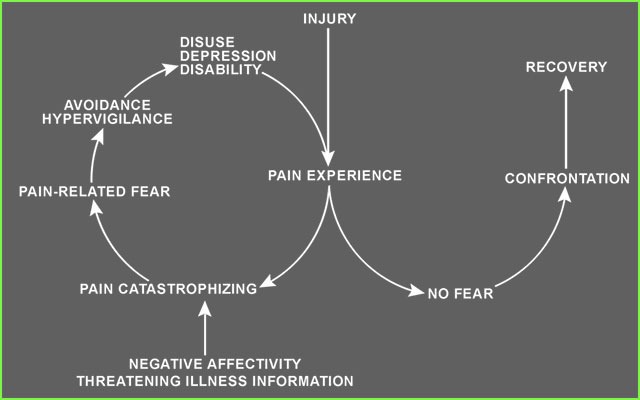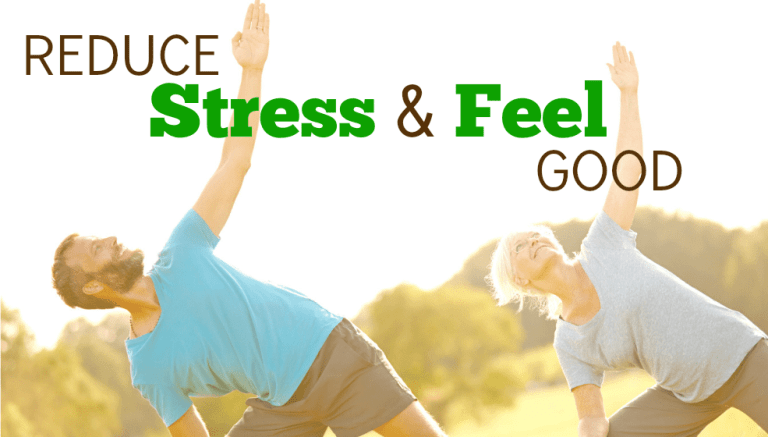Overcome Your Fear and Conquer Your Pain

If you are reading this post, you are probably already well-versed in how chronic pain can interrupt your own — or a loved one’s — ability to perform simple activities and function on a day-to-day basis. You may even start off your day dreading the thought of just trying to get through it. When we hurt, we tend to shut down physically and even emotionally. It is our natural tendency to protect a part of our body that has been injured or is uncomfortable. If our right leg hurts, then we naturally shift our weight to our left leg. This basic, inherent guarded behavior pattern can be considered protective at times of acute injury. When we first sprain our ankle, staying off of it for a few weeks helps it heal.
Unfortunately, this behavior pattern loses its protective benefit once the condition lingers and/or the pain becomes more chronic. In fact, this avoidance behavior is generally believed by many pain experts to significantly contribute to the severity of chronic pain symptoms. The medical term for this is fear-avoidance, and it defines a thought process in which an individual fears the presence or potential exacerbation of pain to the point of avoiding activities. Unlike the acute injury model, developing fear-avoidant behaviors when dealing with chronic conditions becomes maladaptive in that it increases one’s physical disability and contributes to emotional distress.
Let’s go back to the example of the sprained ankle and suppose we stay off of it, not just for a few weeks, but rather for six months. In this scenario avoiding using the injured body part becomes harmful, as opposed to helpful, to the healing process. Staying off of the injured leg for a prolonged period of time can lead to all kinds of physical changes, including a stiffening of the joints, muscle atrophy throughout the whole limb, and scar tissue build up. Physical changes will start to occur throughout the rest of the body as well, which will cause problems like postural changes and overuse of other parts like the uninjured leg. Once we become fearful of re-engaging our bodies after it is in pain or has been injured, then this avoidance behavior gradually leads to changes that ultimately leave us much more disabled and, sadly, in even more pain.
Inactivity and avoidance should be considered painful. In the example above where we stop using one of our legs for six months, you can imagine that the leg will hurt more and more as it gets weaker and stiffer, and the longer we wait, the more it will hurt when we try to use it. If we continue to over-use our good leg, then it will also start to hurt from the excessive pressure exerted on it. In my experience, disrupted gait patterns eventually lead to lower back pain, too. Now, if we add assistive devices like canes or crutches, then we run the risk of straining our hands, arms and shoulders, too. Before you know it, we are practically hurting all over.
Overcoming fear-avoidance is tricky business, but an important part of winning the battle against pain. Our pain changes the way we think and makes it difficult for us to recognize when we have developed irrational fears or behavior patterns that stand in the way of getting better and feeling better. Most folks need some help seeing past the pain to start believing that moving something that hurts will eventually help make it stronger and less painful. For some, working with experts in movement like high-quality physical therapists, Pilates instructors, or trainers can help get the ball rolling. In other cases, learning tools to better manage anxiety and fear through special techniques like relaxation training and breathing exercises can have a big impact. Achieving just small but steady gains over time can eventually lead to larger triumphs and personal transformations. I routinely see patients come in with walkers, canes, and all sorts of physical limitations that are able to learn how to walk, climb stairs and, in some cases, even jog on a treadmill. Overcoming chronic pain can mean working through some serious fears and misconceptions about your condition, but the rewards make it so worth it.
Peter Abaci, MD, is one of the world’s leading experts on pain. He is the author of Take Charge of Your Chronic Pain: The Latest Research, Cutting-Edge Tools, and Alternative Treatments for Feeling Better, host of Health Revolution Radio, and a regular contributor to WebMD, The Huffington Post, and PainReliefRevolution.com. His newly released second book, Conquer Your Chronic Pain, A Life-Changing Drug-Free Approach for Relief, Recovery, and Restoration, is already considered a must read for anyone dealing with chronic pain. As the Medical Director and Co-Founder of the renowned Bay Area Pain and Wellness Center his innovative strategies for integrative pain treatment have helped restore the lives of thousands struggling with pain. Dr. Abaci’s publications on pain treatment have become a trusted resource for patients, family members, doctors, psychologists, physical therapists, and insurance companies, alike. He resides with his family in Los Gatos, California.See more at: peterabaci.com
PainPathways Magazine
PainPathways is the first, only and ultimate pain magazine. First published in spring 2008, PainPathways is the culmination of the vision of Richard L. Rauck, MD, to provide a shared resource for people living with and caring for others in pain. This quarterly resource not only provides in-depth information on current treatments, therapies and research studies but also connects people who live with pain, both personally and professionally.
View All By PainPathways






